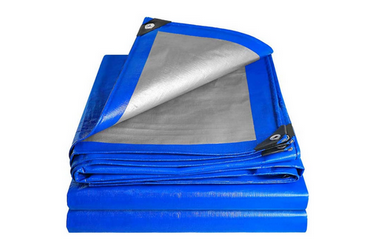What Is a Tarpaulin?

A tarpaulin (also called a tarp) is a large, flexible sheet of strong, water-resistant or waterproof material, commonly made from coated cloth like canvas or synthetic fabrics such as polyethylene, PVC, polyester, polypropylene, and more.It typically includes reinforced grommets along its edges, allowing the tarp to be tied down securely with rope, hooks, or bungee cords.
Types of Tarpaulins
| Material | Key Features | Common Uses |
|---|---|---|
| Polyethylene (PE) | Lightweight; waterproof; UV‑treated versions last a few years | Camping, covering loads, shelter |
| PVC / Vinyl | Very durable; waterproof, abrasion- and chemical-resistant | Industrial covers, transport, scaffolding |
| Canvas | Breathable when coated; water-resistant but not fully waterproof | Light rain, agriculture, traditional use |
| Mesh | Permits airflow while blocking wind/debris | Shade covers, scaffolding, privacy screens |
It typically includes reinforced grommets along its edges, allowing the tarp to be tied down securely with rope, hooks, or bungee cords.
Common Uses
Provides weather protection and shelter: used for roofing, debris control on construction sites, and covering boats, machinery, or wood piles .
Acts as temporary structures: camping ground sheets, flysheets, charity or military shelters (“basha”) .
Serves as transport covers for trucks, goods, and agricultural products .
Used in event and advertising: printed tarps for billboards, banners, and scaffolding mesh .
Why Choose the Right Tarp?
Material Suitability
PE: affordable and waterproof for light-duty needs.
PVC: heavy-duty, resistant to chemicals and harsh weather.
Canvas: offers breathability; good for minimizing moisture build-up.
Mesh: ideal where wind flow and partial shade are needed.
Durability & Lifespan
PVC: lasts ~3–5 years
PE: ~1–2 years, unless UV‑treated
Canvas/Oxford: ~2–4 years depending on maintenance
Reinforcements & Features
Look for grommets, rope channels, flame-retardant treatments, and thickness (mils/oz) for your intended use .
Choosing the Right Tarpaulin
To pick the best tarp:
Define the application: camping, construction, transport, shielding, etc.
Choose the material to match your needs (waterproofness, weather resistance, strength).
Ensure the size, thickness, and reinforcements like grommets align with usage.
Consider price versus lifespan, and maintenance requirements.

 Send Email
Send Email +86 17056906088
+86 17056906088